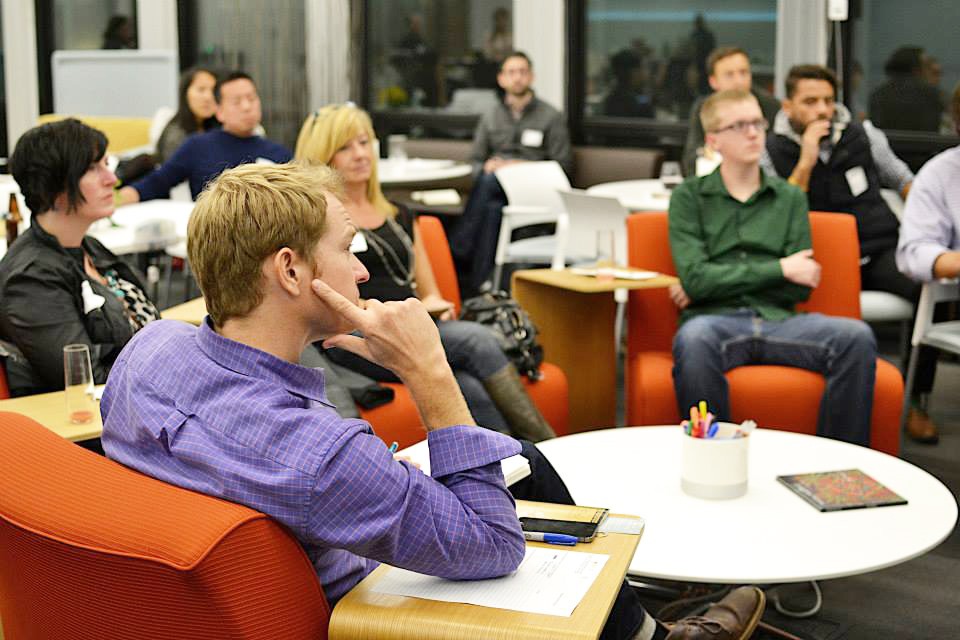
Farewell...
Workspring has chosen not to renew its lease in downtown Chicago. It has been our team’s pleasure to provide thousands of training, brainstorming and strategizing experiences to companies across the globe, and we are grateful to all of our customers. If you need to contact us, email info@workspring.com.
10 Secrets To Running Meetings Like The Top Innovative Companies

Meetings can be a source of creativity and motivation – a time when team collaboration and leadership combine and create the space for achieving organizational goals. Maybe in an ideal world. Unfortunately, more often, meetings are just an unproductive and inefficient waste of time.
There’s a secret to running meetings that energise rather than demoralise. Here are 10 things the world’s top innovative companies do to keep meetings productive:
1. Apple – Small groups of smart people
A meeting is not a party, so “the more the merrier” does not apply. Steve Jobs was notorious for insisting that meetings should be small groups of smart people – and he wouldn’t hesitate to let someone know if they weren’t needed. Experts suggest there should be no more than 10 people at a meeting – so pick your invitees wisely.
2. TED – Keep it short
There’s nothing worse than being stuck in a meeting watching the clock tick by. Meetings should not drag on for hours – or even half an hour. Research shows that our attention span is between 10 – 18 minutes, so the most innovative organisations know that meetings should be short. TED has proven that a lot can happen in 18 minutes.
3. Google – Appoint a decision maker
The secret to Google’s success is not acting like a large multi-billion dollar company – it’s acting “like a hungry startup”, according to CEO Larry Page. A problem with big companies is the increased red tape and bureaucracy that comes from having so many separate departments (corporate, operations, sales etc). This leads to increased meetings and slower decisions. So, Google has adopted a “buck stops here” approach to streamline decision making in meetings.
4. 3M – Allow free time
Meetings need agendas and purpose – but innovation and creativity also need room to breathe. 3M created the 15% Program to allow its employees (paid) time out of their working day to generate ideas and pursue creative endeavours – that started in 1948! Over 50 years has proven that the best-selling products and services come out of allowing this free time and space. Google has followed suit and upped the ante with 20% free time, which famously led to the creation of Gmail and Google Earth. So, whether it’s before/during/after a meeting, allow free time for creative thoughts to flow.
5. Facebook – Have an agenda
This is really a big one and arguably pretty obvious. Facebook COO, Sheryl Sandberg, insists an agenda is crucial for meetings and always has a spiral notebook with her to ensure that each item is ticked off. Ideally, the agenda should be circulated in advance and have some flexibility – it doesn’t need to be a detailed list but should reflect the purpose and objectives of the meeting. This leads to my next point…
6. American Express – Know your purpose
All meetings should have a clearly defined purpose or problem to solve. Christopher Frank, the VP for American Express, says you should be able to articulate that purpose or problem in 5 words or less. He told Forbes, this gives “a good idea of the information you need, the people you should talk to and will ensure everyone is working towards the same goal.” It’s not always easy! As Dr Seuss says, sometimes the questions are complicated and the answers are simple.
7. Upfront Ventures – Leave the laptops
Mark Suster – a successful entrepreneur, angel investor and venture capitalist – says laptops have no place in meeting rooms. Everyone should be fully engaged and attentive in a productive meeting and laptops rarely facilitate this. What about note taking? Well, research shows that conceptual recall is much better after taking handwritten notes than on a laptop anyway. If it’s going to be a long meeting (but see #2 above), schedule a 15 minute email break.
8. Amazon – Get rid of PowerPoint
We all love a good pie chart or line graph, but CEO and founder of Amazon (Jeff Bezos) has banned PowerPoint in his meetings. Nobody enjoys death by a thousand slides. Jeff argues that PowerPoint is easy for presenters but difficult for the audience. Unless you are a PowerPoint pro, stick to bullet points.
9. Yahoo – Use data
The CEO of the $35 billion internet portal is (unsurprisingly) a firm believer in the power of facts and figures in meetings. She considers data to be an equalizer. It also prevents the meeting from succumbing to office politics and opinion-induced debates. Don’t interpret “data” too conservatively though – a balance of qualitative and quantitative information is usually the most well-received.
10. Nike – Doodle away
A 2009 study at the University of Plymouth found that doodlers can retain 29% more information than non-doodlers in meetings and lectures. It’s no surprise then that Nike CEO, Mark Parker, is often found with a moleskine notebook and pen in hand during meetings – he says it helps the brainstorming process. The $15.9 billion empire was probably built on a foundation of designs sketched in meetings on a Tuesday afternoon.
Now you’ve got all the tools to create motivating and productive meetings in your workplace. You’ll be having 15 minute standing team updates in the park, throwing around a tennis ball, in no time. Still, remember – no meeting is better than a bad meeting.
Read about a few more companies on LifeHack here.
Workspring offers more than just meeting space. We offer an experience that helps you do your best work ever. Call or email us to schedule a tour of our space at 800 605 9092 or ashley@workspring.com.